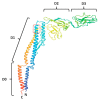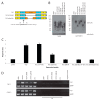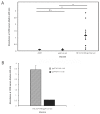DNA Vaccine-Encoded Flagellin Can Be Used as an Adjuvant Scaffold to Augment HIV-1 gp41 Membrane Proximal External Region Immunogenicity
- PMID: 29495537
- PMCID: PMC5869493
- DOI: 10.3390/v10030100
DNA Vaccine-Encoded Flagellin Can Be Used as an Adjuvant Scaffold to Augment HIV-1 gp41 Membrane Proximal External Region Immunogenicity
Abstract
Flagellin's potential as a vaccine adjuvant has been increasingly explored over the last three decades. Monomeric flagellin proteins are the only known agonists of Toll-like receptor 5 (TLR5). This interaction evokes a pro-inflammatory state that impacts upon both innate and adaptive immunity. While pathogen associated molecular patterns (PAMPs) like flagellin have been used as stand-alone adjuvants that are co-delivered with antigen, some investigators have demonstrated a distinct advantage to incorporating antigen epitopes within the structure of flagellin itself. This approach has been particularly effective in enhancing humoral immune responses. We sought to use flagellin as both scaffold and adjuvant for HIV gp41 with the aim of eliciting antibodies to the membrane proximal external region (MPER). Accordingly, we devised a straightforward step-wise approach to select flagellin-antigen fusion proteins for gene-based vaccine development. Using plasmid DNA vector-based expression in mammalian cells, we demonstrate robust expression of codon-optimized full length and hypervariable region-deleted constructs of Salmonella enterica subsp. enterica serovar Typhi flagellin (FliC). An HIV gp41 derived sequence including the MPER (gp41607-683) was incorporated into various positions of these constructs and the expressed fusion proteins were screened for effective secretion, TLR5 agonist activity and adequate MPER antigenicity. We show that incorporation of gp41607-683 into a FliC-based scaffold significantly augments gp41607-683 immunogenicity in a TLR5 dependent manner and elicits modest MPER-specific humoral responses in a mouse model.
Keywords: DNA vaccine; HIV-1; MPER; adjuvant; flagellin; gp41; membrane proximal external region.
Conflict of interest statement
The authors have no conflict of interest to declare.
Figures








Similar articles
-
Harnessing flagellin of Ligilactobacillus agilis as a surface display scaffold for an HIV-1 epitope.Appl Environ Microbiol. 2025 Jun 18;91(6):e0067425. doi: 10.1128/aem.00674-25. Epub 2025 May 29. Appl Environ Microbiol. 2025. PMID: 40439423 Free PMC article.
-
Development of a DNA vaccine expressing a secreted HIV-1 gp41 ectodomain that includes the membrane-proximal external region.Vaccine. 2017 May 9;35(20):2736-2744. doi: 10.1016/j.vaccine.2017.03.039. Epub 2017 Apr 6. Vaccine. 2017. PMID: 28392143
-
Immunogens Modeling a Fusion-Intermediate Conformation of gp41 Elicit Antibodies to the Membrane Proximal External Region of the HIV Envelope Glycoprotein.PLoS One. 2015 Jun 18;10(6):e0128562. doi: 10.1371/journal.pone.0128562. eCollection 2015. PLoS One. 2015. PMID: 26087072 Free PMC article.
-
The development of HIV vaccines targeting gp41 membrane-proximal external region (MPER): challenges and prospects.Protein Cell. 2018 Jul;9(7):596-615. doi: 10.1007/s13238-018-0534-7. Epub 2018 Apr 17. Protein Cell. 2018. PMID: 29667004 Free PMC article. Review.
-
The Use of Liposomes to Shape Epitope Structure and Modulate Immunogenic Responses of Peptide Vaccines Against HIV MPER.Adv Protein Chem Struct Biol. 2015;99:15-54. doi: 10.1016/bs.apcsb.2015.03.002. Epub 2015 Apr 18. Adv Protein Chem Struct Biol. 2015. PMID: 26067815 Review.
Cited by
-
The Ectopic Expression of SurvivinT34A and FilC Can Enhance the Oncolytic Effects of Vaccinia Virus in Murine Gastric Cancer.Onco Targets Ther. 2020 Feb 3;13:1011-1025. doi: 10.2147/OTT.S230902. eCollection 2020. Onco Targets Ther. 2020. PMID: 32099404 Free PMC article.
-
Genetic adjuvants: A paradigm shift in vaccine development and immune modulation.Mol Ther Nucleic Acids. 2025 Apr 8;36(2):102536. doi: 10.1016/j.omtn.2025.102536. eCollection 2025 Jun 10. Mol Ther Nucleic Acids. 2025. PMID: 40336572 Free PMC article. Review.
-
Epidemiology of Δ8THC-Related Carcinogenesis in USA: A Panel Regression and Causal Inferential Study.Int J Environ Res Public Health. 2022 Jun 23;19(13):7726. doi: 10.3390/ijerph19137726. Int J Environ Res Public Health. 2022. PMID: 35805384 Free PMC article.
-
Glycan masking in vaccine design: Targets, immunogens and applications.Front Immunol. 2023 Mar 23;14:1126034. doi: 10.3389/fimmu.2023.1126034. eCollection 2023. Front Immunol. 2023. PMID: 37033915 Free PMC article. Review.
-
Inserting Omp22 into the flagellin protein, replacing its hypervariable region, results in stronger protection against lethal Acinetobacter baumannii infection.Sci Rep. 2024 Nov 12;14(1):27646. doi: 10.1038/s41598-024-79013-x. Sci Rep. 2024. PMID: 39533090 Free PMC article.
References
Publication types
MeSH terms
Substances
Grants and funding
LinkOut - more resources
Full Text Sources
Other Literature Sources
Medical

